Viral Vaccines: Production, Types, Advantages, and Diseases
VerifiedAdded on 2020/05/04
|11
|2224
|50
Report
AI Summary
This report provides a comprehensive overview of viral vaccines, beginning with an introduction to the field of immunology and the importance of vaccination. It details the different types of viral vaccines, including inactivated and attenuated vaccines, as well as viral vector vaccines. The advantages and disadvantages of each type are discussed, with a focus on live-attenuated vaccines and their ability to generate robust immune responses. The report further explores the process of vaccine production, using the Hepatitis B vaccine as a case study, and includes figures illustrating the steps involved in vaccine manufacturing. Finally, the report addresses diseases associated with viral vaccines, such as HIV/AIDS, and highlights the significance of viral vaccines in combating these deadly infections. The conclusion emphasizes the ongoing need for research to develop safer and more effective viral vaccines.
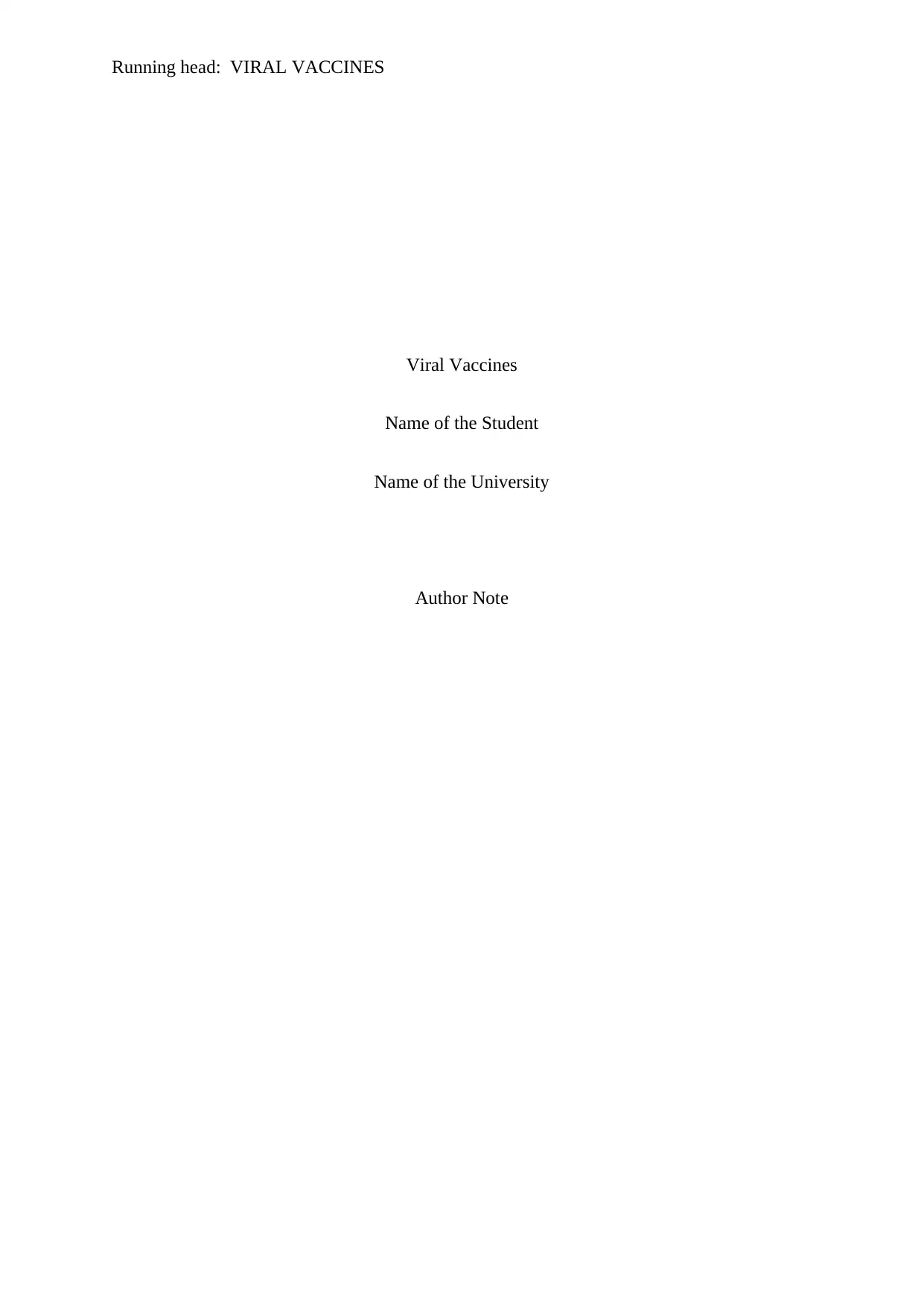
Running head: VIRAL VACCINES
Viral Vaccines
Name of the Student
Name of the University
Author Note
Viral Vaccines
Name of the Student
Name of the University
Author Note
Paraphrase This Document
Need a fresh take? Get an instant paraphrase of this document with our AI Paraphraser
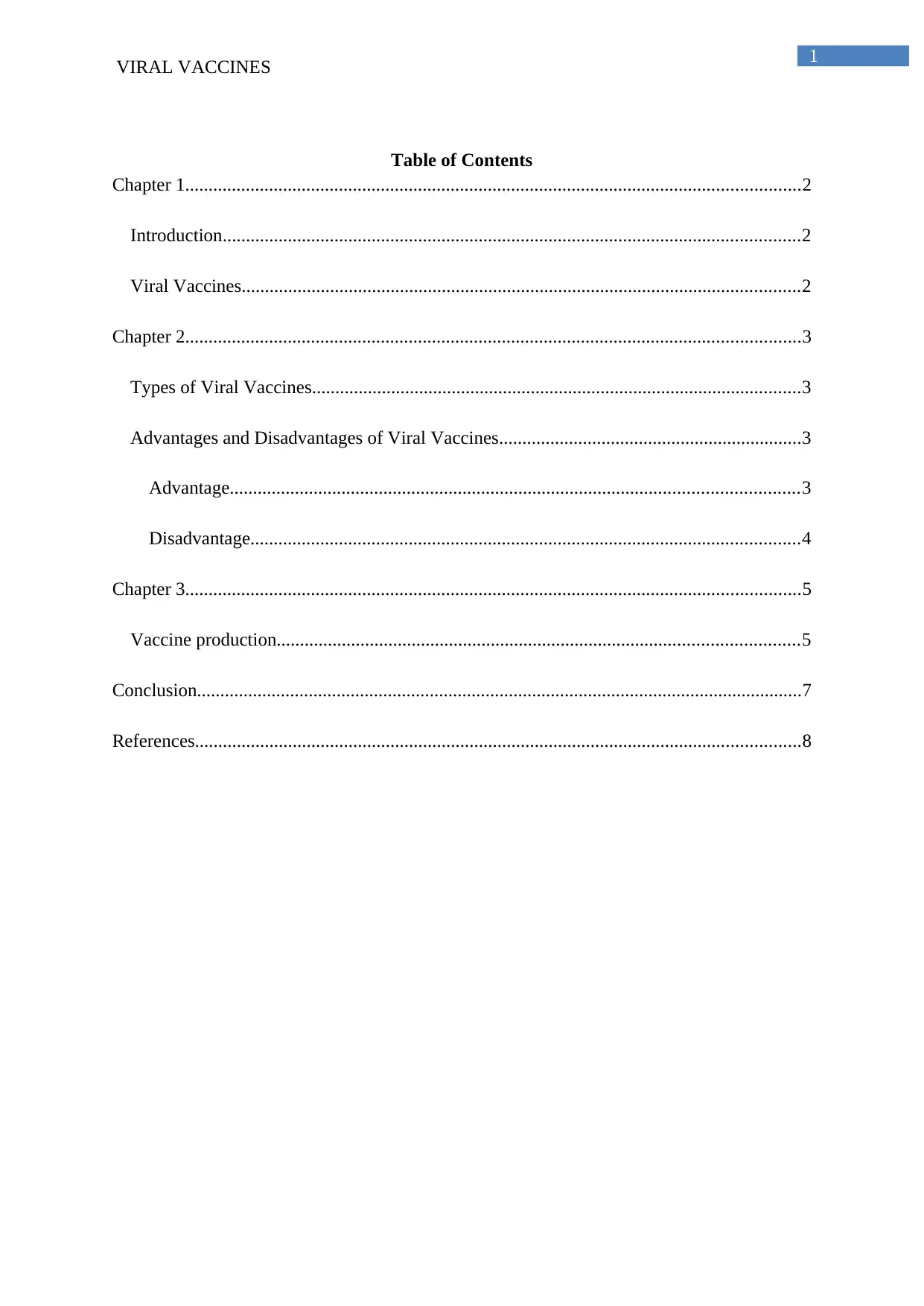
1
VIRAL VACCINES
Table of Contents
Chapter 1....................................................................................................................................2
Introduction............................................................................................................................2
Viral Vaccines........................................................................................................................2
Chapter 2....................................................................................................................................3
Types of Viral Vaccines.........................................................................................................3
Advantages and Disadvantages of Viral Vaccines.................................................................3
Advantage..........................................................................................................................3
Disadvantage......................................................................................................................4
Chapter 3....................................................................................................................................5
Vaccine production................................................................................................................5
Conclusion..................................................................................................................................7
References..................................................................................................................................8
VIRAL VACCINES
Table of Contents
Chapter 1....................................................................................................................................2
Introduction............................................................................................................................2
Viral Vaccines........................................................................................................................2
Chapter 2....................................................................................................................................3
Types of Viral Vaccines.........................................................................................................3
Advantages and Disadvantages of Viral Vaccines.................................................................3
Advantage..........................................................................................................................3
Disadvantage......................................................................................................................4
Chapter 3....................................................................................................................................5
Vaccine production................................................................................................................5
Conclusion..................................................................................................................................7
References..................................................................................................................................8
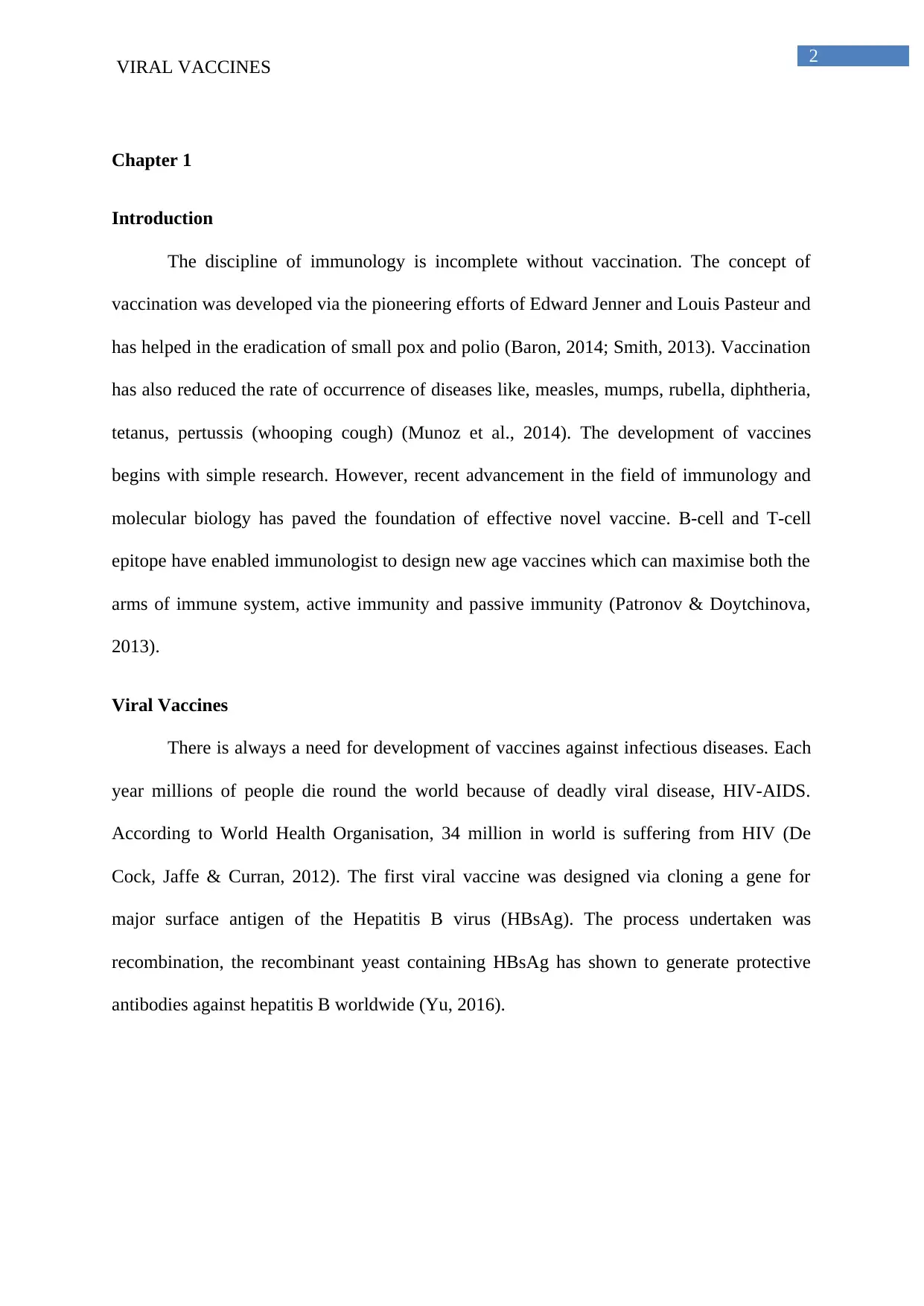
2
VIRAL VACCINES
Chapter 1
Introduction
The discipline of immunology is incomplete without vaccination. The concept of
vaccination was developed via the pioneering efforts of Edward Jenner and Louis Pasteur and
has helped in the eradication of small pox and polio (Baron, 2014; Smith, 2013). Vaccination
has also reduced the rate of occurrence of diseases like, measles, mumps, rubella, diphtheria,
tetanus, pertussis (whooping cough) (Munoz et al., 2014). The development of vaccines
begins with simple research. However, recent advancement in the field of immunology and
molecular biology has paved the foundation of effective novel vaccine. B-cell and T-cell
epitope have enabled immunologist to design new age vaccines which can maximise both the
arms of immune system, active immunity and passive immunity (Patronov & Doytchinova,
2013).
Viral Vaccines
There is always a need for development of vaccines against infectious diseases. Each
year millions of people die round the world because of deadly viral disease, HIV-AIDS.
According to World Health Organisation, 34 million in world is suffering from HIV (De
Cock, Jaffe & Curran, 2012). The first viral vaccine was designed via cloning a gene for
major surface antigen of the Hepatitis B virus (HBsAg). The process undertaken was
recombination, the recombinant yeast containing HBsAg has shown to generate protective
antibodies against hepatitis B worldwide (Yu, 2016).
VIRAL VACCINES
Chapter 1
Introduction
The discipline of immunology is incomplete without vaccination. The concept of
vaccination was developed via the pioneering efforts of Edward Jenner and Louis Pasteur and
has helped in the eradication of small pox and polio (Baron, 2014; Smith, 2013). Vaccination
has also reduced the rate of occurrence of diseases like, measles, mumps, rubella, diphtheria,
tetanus, pertussis (whooping cough) (Munoz et al., 2014). The development of vaccines
begins with simple research. However, recent advancement in the field of immunology and
molecular biology has paved the foundation of effective novel vaccine. B-cell and T-cell
epitope have enabled immunologist to design new age vaccines which can maximise both the
arms of immune system, active immunity and passive immunity (Patronov & Doytchinova,
2013).
Viral Vaccines
There is always a need for development of vaccines against infectious diseases. Each
year millions of people die round the world because of deadly viral disease, HIV-AIDS.
According to World Health Organisation, 34 million in world is suffering from HIV (De
Cock, Jaffe & Curran, 2012). The first viral vaccine was designed via cloning a gene for
major surface antigen of the Hepatitis B virus (HBsAg). The process undertaken was
recombination, the recombinant yeast containing HBsAg has shown to generate protective
antibodies against hepatitis B worldwide (Yu, 2016).
⊘ This is a preview!⊘
Do you want full access?
Subscribe today to unlock all pages.

Trusted by 1+ million students worldwide
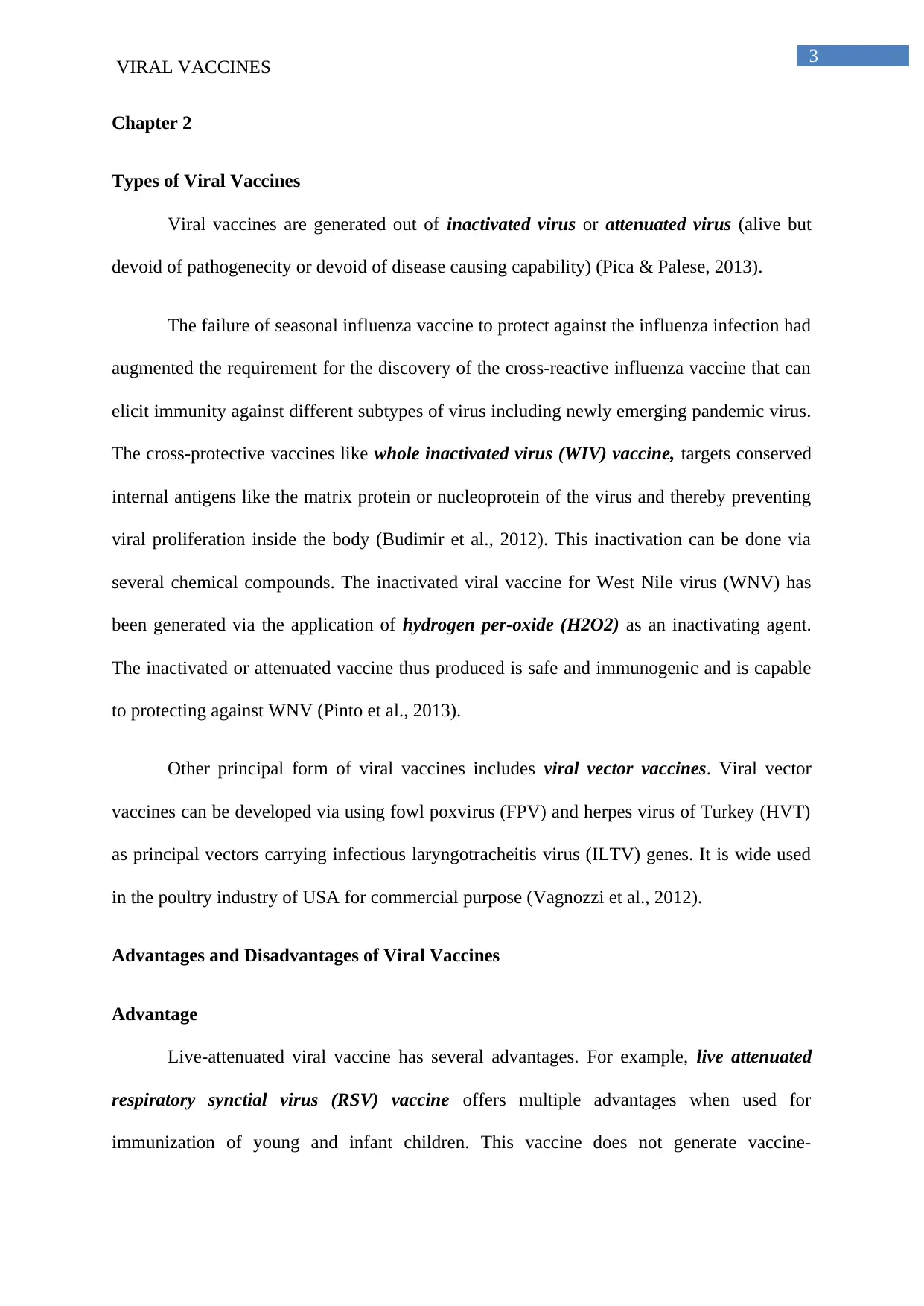
3
VIRAL VACCINES
Chapter 2
Types of Viral Vaccines
Viral vaccines are generated out of inactivated virus or attenuated virus (alive but
devoid of pathogenecity or devoid of disease causing capability) (Pica & Palese, 2013).
The failure of seasonal influenza vaccine to protect against the influenza infection had
augmented the requirement for the discovery of the cross-reactive influenza vaccine that can
elicit immunity against different subtypes of virus including newly emerging pandemic virus.
The cross-protective vaccines like whole inactivated virus (WIV) vaccine, targets conserved
internal antigens like the matrix protein or nucleoprotein of the virus and thereby preventing
viral proliferation inside the body (Budimir et al., 2012). This inactivation can be done via
several chemical compounds. The inactivated viral vaccine for West Nile virus (WNV) has
been generated via the application of hydrogen per-oxide (H2O2) as an inactivating agent.
The inactivated or attenuated vaccine thus produced is safe and immunogenic and is capable
to protecting against WNV (Pinto et al., 2013).
Other principal form of viral vaccines includes viral vector vaccines. Viral vector
vaccines can be developed via using fowl poxvirus (FPV) and herpes virus of Turkey (HVT)
as principal vectors carrying infectious laryngotracheitis virus (ILTV) genes. It is wide used
in the poultry industry of USA for commercial purpose (Vagnozzi et al., 2012).
Advantages and Disadvantages of Viral Vaccines
Advantage
Live-attenuated viral vaccine has several advantages. For example, live attenuated
respiratory synctial virus (RSV) vaccine offers multiple advantages when used for
immunization of young and infant children. This vaccine does not generate vaccine-
VIRAL VACCINES
Chapter 2
Types of Viral Vaccines
Viral vaccines are generated out of inactivated virus or attenuated virus (alive but
devoid of pathogenecity or devoid of disease causing capability) (Pica & Palese, 2013).
The failure of seasonal influenza vaccine to protect against the influenza infection had
augmented the requirement for the discovery of the cross-reactive influenza vaccine that can
elicit immunity against different subtypes of virus including newly emerging pandemic virus.
The cross-protective vaccines like whole inactivated virus (WIV) vaccine, targets conserved
internal antigens like the matrix protein or nucleoprotein of the virus and thereby preventing
viral proliferation inside the body (Budimir et al., 2012). This inactivation can be done via
several chemical compounds. The inactivated viral vaccine for West Nile virus (WNV) has
been generated via the application of hydrogen per-oxide (H2O2) as an inactivating agent.
The inactivated or attenuated vaccine thus produced is safe and immunogenic and is capable
to protecting against WNV (Pinto et al., 2013).
Other principal form of viral vaccines includes viral vector vaccines. Viral vector
vaccines can be developed via using fowl poxvirus (FPV) and herpes virus of Turkey (HVT)
as principal vectors carrying infectious laryngotracheitis virus (ILTV) genes. It is wide used
in the poultry industry of USA for commercial purpose (Vagnozzi et al., 2012).
Advantages and Disadvantages of Viral Vaccines
Advantage
Live-attenuated viral vaccine has several advantages. For example, live attenuated
respiratory synctial virus (RSV) vaccine offers multiple advantages when used for
immunization of young and infant children. This vaccine does not generate vaccine-
Paraphrase This Document
Need a fresh take? Get an instant paraphrase of this document with our AI Paraphraser
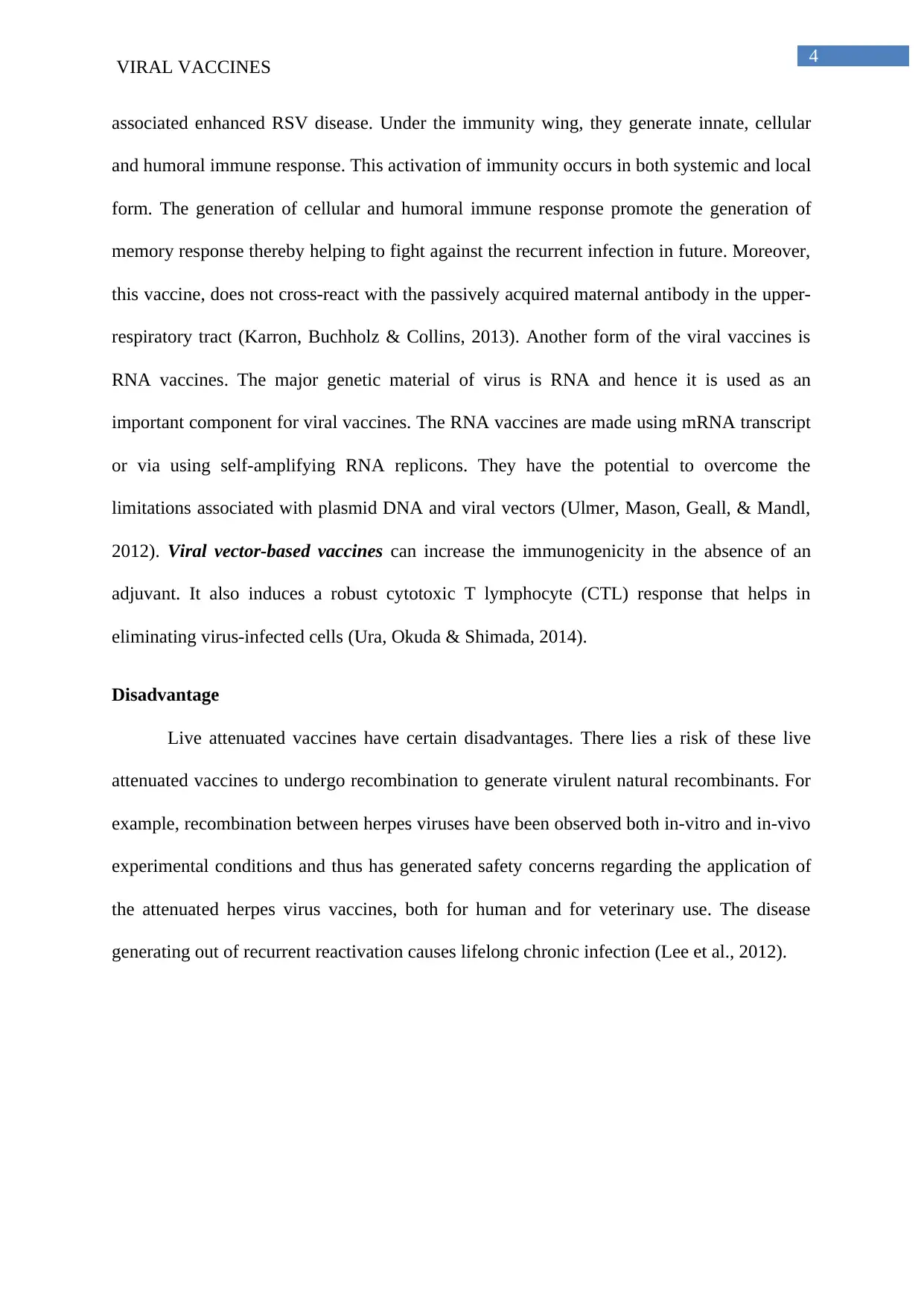
4
VIRAL VACCINES
associated enhanced RSV disease. Under the immunity wing, they generate innate, cellular
and humoral immune response. This activation of immunity occurs in both systemic and local
form. The generation of cellular and humoral immune response promote the generation of
memory response thereby helping to fight against the recurrent infection in future. Moreover,
this vaccine, does not cross-react with the passively acquired maternal antibody in the upper-
respiratory tract (Karron, Buchholz & Collins, 2013). Another form of the viral vaccines is
RNA vaccines. The major genetic material of virus is RNA and hence it is used as an
important component for viral vaccines. The RNA vaccines are made using mRNA transcript
or via using self-amplifying RNA replicons. They have the potential to overcome the
limitations associated with plasmid DNA and viral vectors (Ulmer, Mason, Geall, & Mandl,
2012). Viral vector-based vaccines can increase the immunogenicity in the absence of an
adjuvant. It also induces a robust cytotoxic T lymphocyte (CTL) response that helps in
eliminating virus-infected cells (Ura, Okuda & Shimada, 2014).
Disadvantage
Live attenuated vaccines have certain disadvantages. There lies a risk of these live
attenuated vaccines to undergo recombination to generate virulent natural recombinants. For
example, recombination between herpes viruses have been observed both in-vitro and in-vivo
experimental conditions and thus has generated safety concerns regarding the application of
the attenuated herpes virus vaccines, both for human and for veterinary use. The disease
generating out of recurrent reactivation causes lifelong chronic infection (Lee et al., 2012).
VIRAL VACCINES
associated enhanced RSV disease. Under the immunity wing, they generate innate, cellular
and humoral immune response. This activation of immunity occurs in both systemic and local
form. The generation of cellular and humoral immune response promote the generation of
memory response thereby helping to fight against the recurrent infection in future. Moreover,
this vaccine, does not cross-react with the passively acquired maternal antibody in the upper-
respiratory tract (Karron, Buchholz & Collins, 2013). Another form of the viral vaccines is
RNA vaccines. The major genetic material of virus is RNA and hence it is used as an
important component for viral vaccines. The RNA vaccines are made using mRNA transcript
or via using self-amplifying RNA replicons. They have the potential to overcome the
limitations associated with plasmid DNA and viral vectors (Ulmer, Mason, Geall, & Mandl,
2012). Viral vector-based vaccines can increase the immunogenicity in the absence of an
adjuvant. It also induces a robust cytotoxic T lymphocyte (CTL) response that helps in
eliminating virus-infected cells (Ura, Okuda & Shimada, 2014).
Disadvantage
Live attenuated vaccines have certain disadvantages. There lies a risk of these live
attenuated vaccines to undergo recombination to generate virulent natural recombinants. For
example, recombination between herpes viruses have been observed both in-vitro and in-vivo
experimental conditions and thus has generated safety concerns regarding the application of
the attenuated herpes virus vaccines, both for human and for veterinary use. The disease
generating out of recurrent reactivation causes lifelong chronic infection (Lee et al., 2012).
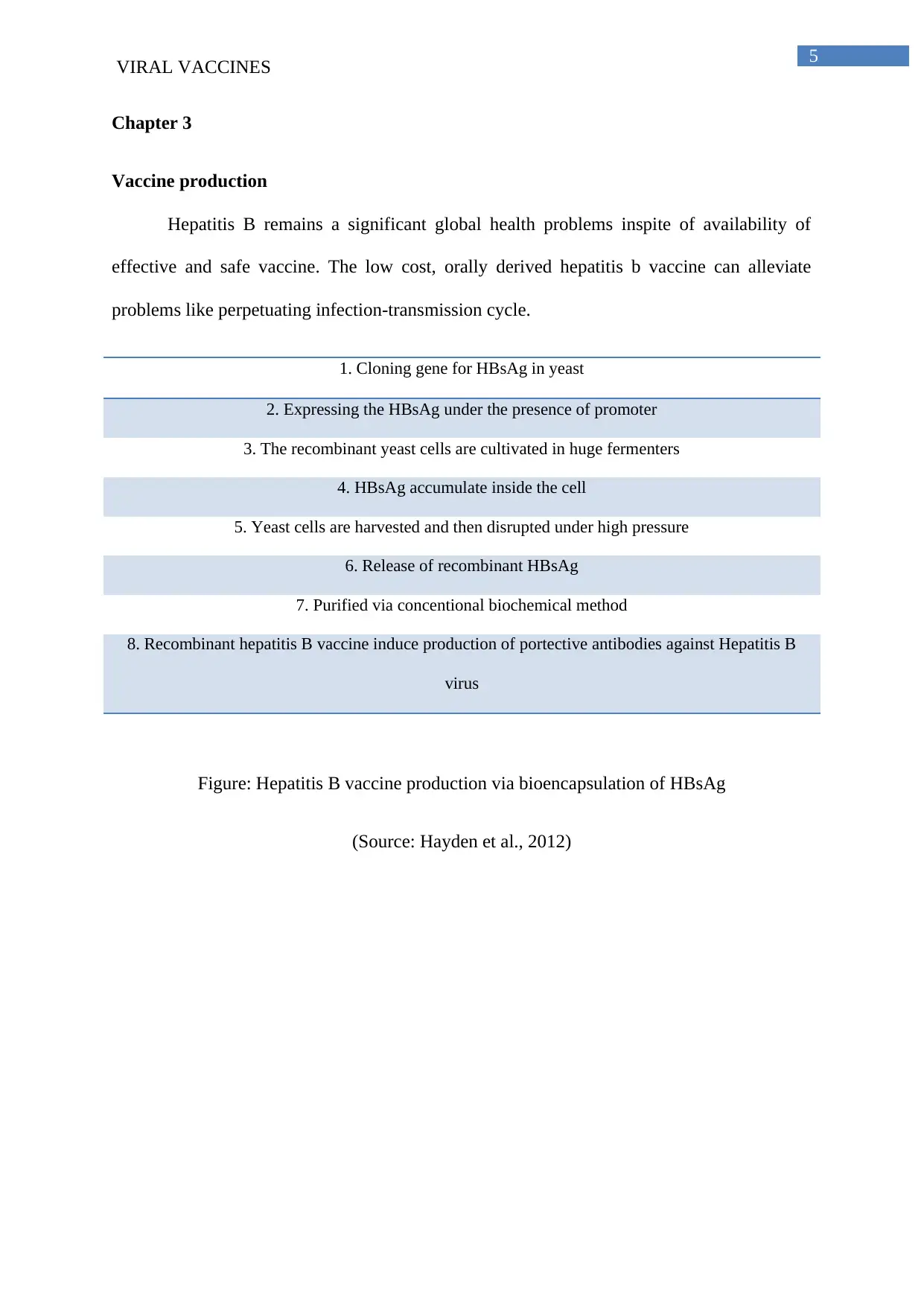
5
VIRAL VACCINES
Chapter 3
Vaccine production
Hepatitis B remains a significant global health problems inspite of availability of
effective and safe vaccine. The low cost, orally derived hepatitis b vaccine can alleviate
problems like perpetuating infection-transmission cycle.
1. Cloning gene for HBsAg in yeast
2. Expressing the HBsAg under the presence of promoter
3. The recombinant yeast cells are cultivated in huge fermenters
4. HBsAg accumulate inside the cell
5. Yeast cells are harvested and then disrupted under high pressure
6. Release of recombinant HBsAg
7. Purified via concentional biochemical method
8. Recombinant hepatitis B vaccine induce production of portective antibodies against Hepatitis B
virus
Figure: Hepatitis B vaccine production via bioencapsulation of HBsAg
(Source: Hayden et al., 2012)
VIRAL VACCINES
Chapter 3
Vaccine production
Hepatitis B remains a significant global health problems inspite of availability of
effective and safe vaccine. The low cost, orally derived hepatitis b vaccine can alleviate
problems like perpetuating infection-transmission cycle.
1. Cloning gene for HBsAg in yeast
2. Expressing the HBsAg under the presence of promoter
3. The recombinant yeast cells are cultivated in huge fermenters
4. HBsAg accumulate inside the cell
5. Yeast cells are harvested and then disrupted under high pressure
6. Release of recombinant HBsAg
7. Purified via concentional biochemical method
8. Recombinant hepatitis B vaccine induce production of portective antibodies against Hepatitis B
virus
Figure: Hepatitis B vaccine production via bioencapsulation of HBsAg
(Source: Hayden et al., 2012)
⊘ This is a preview!⊘
Do you want full access?
Subscribe today to unlock all pages.

Trusted by 1+ million students worldwide

6
VIRAL VACCINES
Figure: Steps for influenza vaccine production
(Source: Partridge & Kieny, 2013)
Figure: Vaccine production and its mechanism within the body
(Source: Riley & Stewart, 2013)
Disease associated with viral vaccines
VIRAL VACCINES
Figure: Steps for influenza vaccine production
(Source: Partridge & Kieny, 2013)
Figure: Vaccine production and its mechanism within the body
(Source: Riley & Stewart, 2013)
Disease associated with viral vaccines
Paraphrase This Document
Need a fresh take? Get an instant paraphrase of this document with our AI Paraphraser

7
VIRAL VACCINES
The most common secondary immuno-deficiency is acquired immunodeficiency
syndrome of AIDS. It is caused by human immunodeficiency virus 1 (HIV-1). The rapid
proliferation of the virus causes instant establishment of a systemic, large viral population,
which is capable of dynamic adaptation under every immune selection pressure. These
viruses always remain one-step ahead than the host immune system. Moreover, the virus
replicates indefinitely in vast majority of infected individuals (Idele et al., 2014). Recent
advancement in medical science has provided evidence that the initial stages of viral infection
via mucosal transmission are comparatively vulnerable to immune intervention. This concept
has lead to the development of vaccine strategy that can elicit responses against the early
stages of viral infection (Picker, Hansen & Lifson, 2012). Other diseases associated with viral
vaccine are influenza, measles mumps rubella (MMR), chicken pox, hepatitis B (Bennett,
Dolin & Blaser, 2014). Here lies the importance of the viral vaccines as it helps in the
treatment of the deadly diseases, which caused recurrent infections and are fatal.
Conclusion
Thus from the above discussion it can be concluded that viral vaccine occupy a
significant portion of vaccine development in immunology. There are different types of virus
vaccines used like live attenuate viral vaccines and viral vector vaccines. The successful use
of the vaccines has been proved helpful to reduce the incidence of several diseases. However,
more research studies are required to be undertaken in order to generate ethically safe viral
vaccines for the treatment of deadly viral disease like HIV AIDS.
VIRAL VACCINES
The most common secondary immuno-deficiency is acquired immunodeficiency
syndrome of AIDS. It is caused by human immunodeficiency virus 1 (HIV-1). The rapid
proliferation of the virus causes instant establishment of a systemic, large viral population,
which is capable of dynamic adaptation under every immune selection pressure. These
viruses always remain one-step ahead than the host immune system. Moreover, the virus
replicates indefinitely in vast majority of infected individuals (Idele et al., 2014). Recent
advancement in medical science has provided evidence that the initial stages of viral infection
via mucosal transmission are comparatively vulnerable to immune intervention. This concept
has lead to the development of vaccine strategy that can elicit responses against the early
stages of viral infection (Picker, Hansen & Lifson, 2012). Other diseases associated with viral
vaccine are influenza, measles mumps rubella (MMR), chicken pox, hepatitis B (Bennett,
Dolin & Blaser, 2014). Here lies the importance of the viral vaccines as it helps in the
treatment of the deadly diseases, which caused recurrent infections and are fatal.
Conclusion
Thus from the above discussion it can be concluded that viral vaccine occupy a
significant portion of vaccine development in immunology. There are different types of virus
vaccines used like live attenuate viral vaccines and viral vector vaccines. The successful use
of the vaccines has been proved helpful to reduce the incidence of several diseases. However,
more research studies are required to be undertaken in order to generate ethically safe viral
vaccines for the treatment of deadly viral disease like HIV AIDS.

8
VIRAL VACCINES
References
Baron, J. (2014). The Life of Edward Jenner MD (Vol. 2). Cambridge University Press.
Bennett, J. E., Dolin, R., & Blaser, M. J. (2014). Principles and practice of infectious
diseases. Elsevier Health Sciences.
Budimir, N., Huckriede, A., Meijerhof, T., Boon, L., Gostick, E., Price, D. A., ... & de Haan,
A. (2012). Induction of heterosubtypic cross-protection against influenza by a whole
inactivated virus vaccine: the role of viral membrane fusion activity. PLoS One, 7(1),
e30898.
De Cock, K. M., Jaffe, H. W., & Curran, J. W. (2012). The evolving epidemiology of
HIV/AIDS. Aids, 26(10), 1205-1213.
Hayden, C. A., Streatfield, S. J., Lamphear, B. J., Fake, G. M., Keener, T. K., Walker, J.
H., ... & Howard, J. A. (2012). Bioencapsulation of the hepatitis B surface antigen and
its use as an effective oral immunogen. Vaccine, 30(19), 2937-2942.
Idele, P., Gillespie, A., Porth, T., Suzuki, C., Mahy, M., Kasedde, S., & Luo, C. (2014).
Epidemiology of HIV and AIDS among adolescents: current status, inequities, and
data gaps. JAIDS Journal of Acquired Immune Deficiency Syndromes, 66, S144-S153.
Karron, R. A., Buchholz, U. J., & Collins, P. L. (2013). Live-attenuated respiratory syncytial
virus vaccines. In Challenges and Opportunities for Respiratory Syncytial Virus
Vaccines (pp. 259-284). Springer Berlin Heidelberg.
Lee, S. W., Markham, P. F., Coppo, M. J., Legione, A. R., Markham, J. F., Noormohammadi,
A. H., ... & Devlin, J. M. (2012). Attenuated vaccines can recombine to form virulent
field viruses. Science, 337(6091), 188-188.
VIRAL VACCINES
References
Baron, J. (2014). The Life of Edward Jenner MD (Vol. 2). Cambridge University Press.
Bennett, J. E., Dolin, R., & Blaser, M. J. (2014). Principles and practice of infectious
diseases. Elsevier Health Sciences.
Budimir, N., Huckriede, A., Meijerhof, T., Boon, L., Gostick, E., Price, D. A., ... & de Haan,
A. (2012). Induction of heterosubtypic cross-protection against influenza by a whole
inactivated virus vaccine: the role of viral membrane fusion activity. PLoS One, 7(1),
e30898.
De Cock, K. M., Jaffe, H. W., & Curran, J. W. (2012). The evolving epidemiology of
HIV/AIDS. Aids, 26(10), 1205-1213.
Hayden, C. A., Streatfield, S. J., Lamphear, B. J., Fake, G. M., Keener, T. K., Walker, J.
H., ... & Howard, J. A. (2012). Bioencapsulation of the hepatitis B surface antigen and
its use as an effective oral immunogen. Vaccine, 30(19), 2937-2942.
Idele, P., Gillespie, A., Porth, T., Suzuki, C., Mahy, M., Kasedde, S., & Luo, C. (2014).
Epidemiology of HIV and AIDS among adolescents: current status, inequities, and
data gaps. JAIDS Journal of Acquired Immune Deficiency Syndromes, 66, S144-S153.
Karron, R. A., Buchholz, U. J., & Collins, P. L. (2013). Live-attenuated respiratory syncytial
virus vaccines. In Challenges and Opportunities for Respiratory Syncytial Virus
Vaccines (pp. 259-284). Springer Berlin Heidelberg.
Lee, S. W., Markham, P. F., Coppo, M. J., Legione, A. R., Markham, J. F., Noormohammadi,
A. H., ... & Devlin, J. M. (2012). Attenuated vaccines can recombine to form virulent
field viruses. Science, 337(6091), 188-188.
⊘ This is a preview!⊘
Do you want full access?
Subscribe today to unlock all pages.

Trusted by 1+ million students worldwide
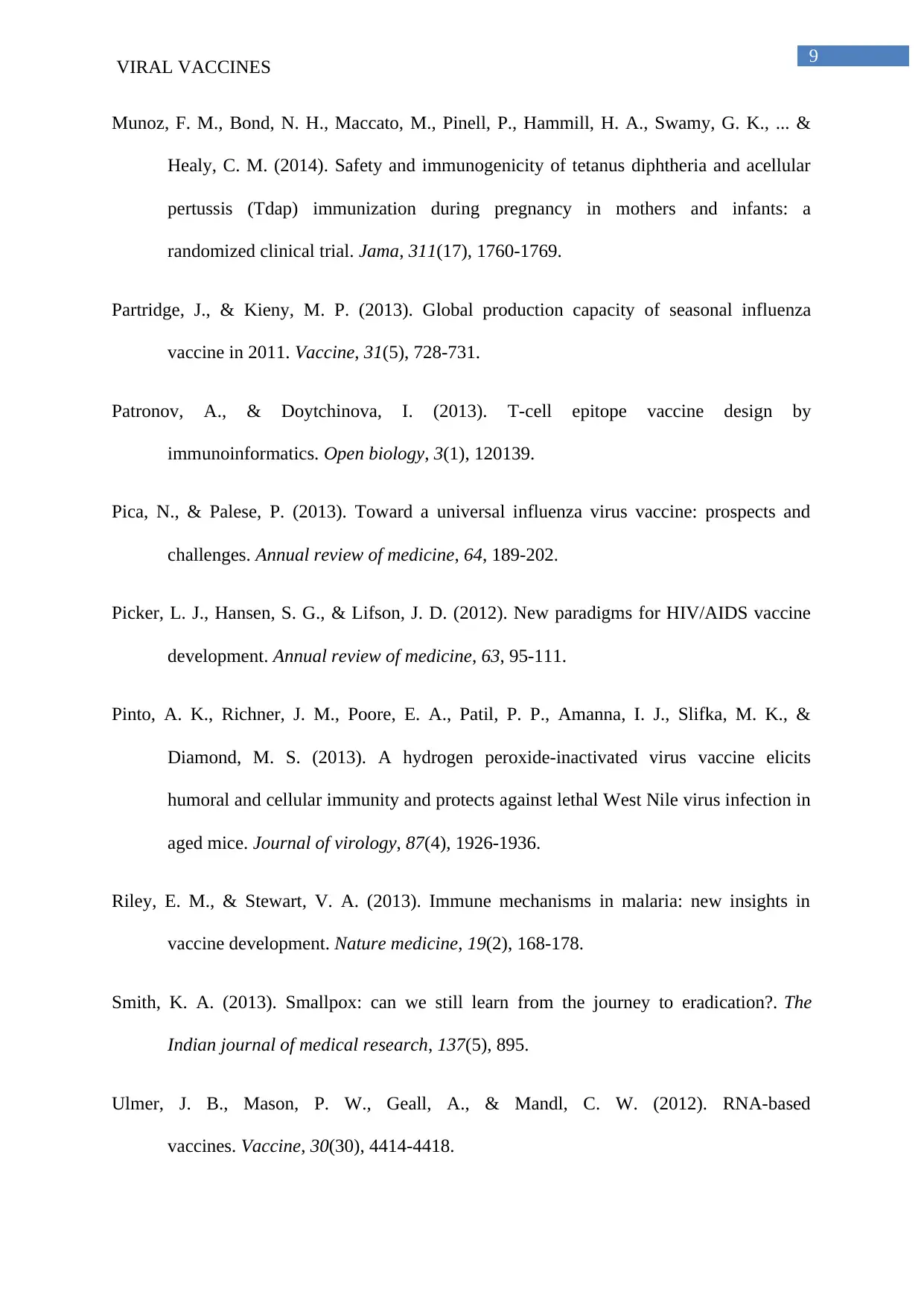
9
VIRAL VACCINES
Munoz, F. M., Bond, N. H., Maccato, M., Pinell, P., Hammill, H. A., Swamy, G. K., ... &
Healy, C. M. (2014). Safety and immunogenicity of tetanus diphtheria and acellular
pertussis (Tdap) immunization during pregnancy in mothers and infants: a
randomized clinical trial. Jama, 311(17), 1760-1769.
Partridge, J., & Kieny, M. P. (2013). Global production capacity of seasonal influenza
vaccine in 2011. Vaccine, 31(5), 728-731.
Patronov, A., & Doytchinova, I. (2013). T-cell epitope vaccine design by
immunoinformatics. Open biology, 3(1), 120139.
Pica, N., & Palese, P. (2013). Toward a universal influenza virus vaccine: prospects and
challenges. Annual review of medicine, 64, 189-202.
Picker, L. J., Hansen, S. G., & Lifson, J. D. (2012). New paradigms for HIV/AIDS vaccine
development. Annual review of medicine, 63, 95-111.
Pinto, A. K., Richner, J. M., Poore, E. A., Patil, P. P., Amanna, I. J., Slifka, M. K., &
Diamond, M. S. (2013). A hydrogen peroxide-inactivated virus vaccine elicits
humoral and cellular immunity and protects against lethal West Nile virus infection in
aged mice. Journal of virology, 87(4), 1926-1936.
Riley, E. M., & Stewart, V. A. (2013). Immune mechanisms in malaria: new insights in
vaccine development. Nature medicine, 19(2), 168-178.
Smith, K. A. (2013). Smallpox: can we still learn from the journey to eradication?. The
Indian journal of medical research, 137(5), 895.
Ulmer, J. B., Mason, P. W., Geall, A., & Mandl, C. W. (2012). RNA-based
vaccines. Vaccine, 30(30), 4414-4418.
VIRAL VACCINES
Munoz, F. M., Bond, N. H., Maccato, M., Pinell, P., Hammill, H. A., Swamy, G. K., ... &
Healy, C. M. (2014). Safety and immunogenicity of tetanus diphtheria and acellular
pertussis (Tdap) immunization during pregnancy in mothers and infants: a
randomized clinical trial. Jama, 311(17), 1760-1769.
Partridge, J., & Kieny, M. P. (2013). Global production capacity of seasonal influenza
vaccine in 2011. Vaccine, 31(5), 728-731.
Patronov, A., & Doytchinova, I. (2013). T-cell epitope vaccine design by
immunoinformatics. Open biology, 3(1), 120139.
Pica, N., & Palese, P. (2013). Toward a universal influenza virus vaccine: prospects and
challenges. Annual review of medicine, 64, 189-202.
Picker, L. J., Hansen, S. G., & Lifson, J. D. (2012). New paradigms for HIV/AIDS vaccine
development. Annual review of medicine, 63, 95-111.
Pinto, A. K., Richner, J. M., Poore, E. A., Patil, P. P., Amanna, I. J., Slifka, M. K., &
Diamond, M. S. (2013). A hydrogen peroxide-inactivated virus vaccine elicits
humoral and cellular immunity and protects against lethal West Nile virus infection in
aged mice. Journal of virology, 87(4), 1926-1936.
Riley, E. M., & Stewart, V. A. (2013). Immune mechanisms in malaria: new insights in
vaccine development. Nature medicine, 19(2), 168-178.
Smith, K. A. (2013). Smallpox: can we still learn from the journey to eradication?. The
Indian journal of medical research, 137(5), 895.
Ulmer, J. B., Mason, P. W., Geall, A., & Mandl, C. W. (2012). RNA-based
vaccines. Vaccine, 30(30), 4414-4418.
Paraphrase This Document
Need a fresh take? Get an instant paraphrase of this document with our AI Paraphraser

10
VIRAL VACCINES
Ura, T., Okuda, K., & Shimada, M. (2014). Developments in viral vector-based
vaccines. Vaccines, 2(3), 624-641.
Vagnozzi, A., Zavala, G., Riblet, S. M., Mundt, A., & García, M. (2012). Protection induced
by commercially available live-attenuated and recombinant viral vector vaccines
against infectious laryngotracheitis virus in broiler chickens. Avian pathology, 41(1),
21-31.
Yu, W. (2016). Hepatitis B vaccine. Reactions, 1613, 148-6.
VIRAL VACCINES
Ura, T., Okuda, K., & Shimada, M. (2014). Developments in viral vector-based
vaccines. Vaccines, 2(3), 624-641.
Vagnozzi, A., Zavala, G., Riblet, S. M., Mundt, A., & García, M. (2012). Protection induced
by commercially available live-attenuated and recombinant viral vector vaccines
against infectious laryngotracheitis virus in broiler chickens. Avian pathology, 41(1),
21-31.
Yu, W. (2016). Hepatitis B vaccine. Reactions, 1613, 148-6.
1 out of 11
Your All-in-One AI-Powered Toolkit for Academic Success.
+13062052269
info@desklib.com
Available 24*7 on WhatsApp / Email
![[object Object]](/_next/static/media/star-bottom.7253800d.svg)
Unlock your academic potential
Copyright © 2020–2025 A2Z Services. All Rights Reserved. Developed and managed by ZUCOL.

